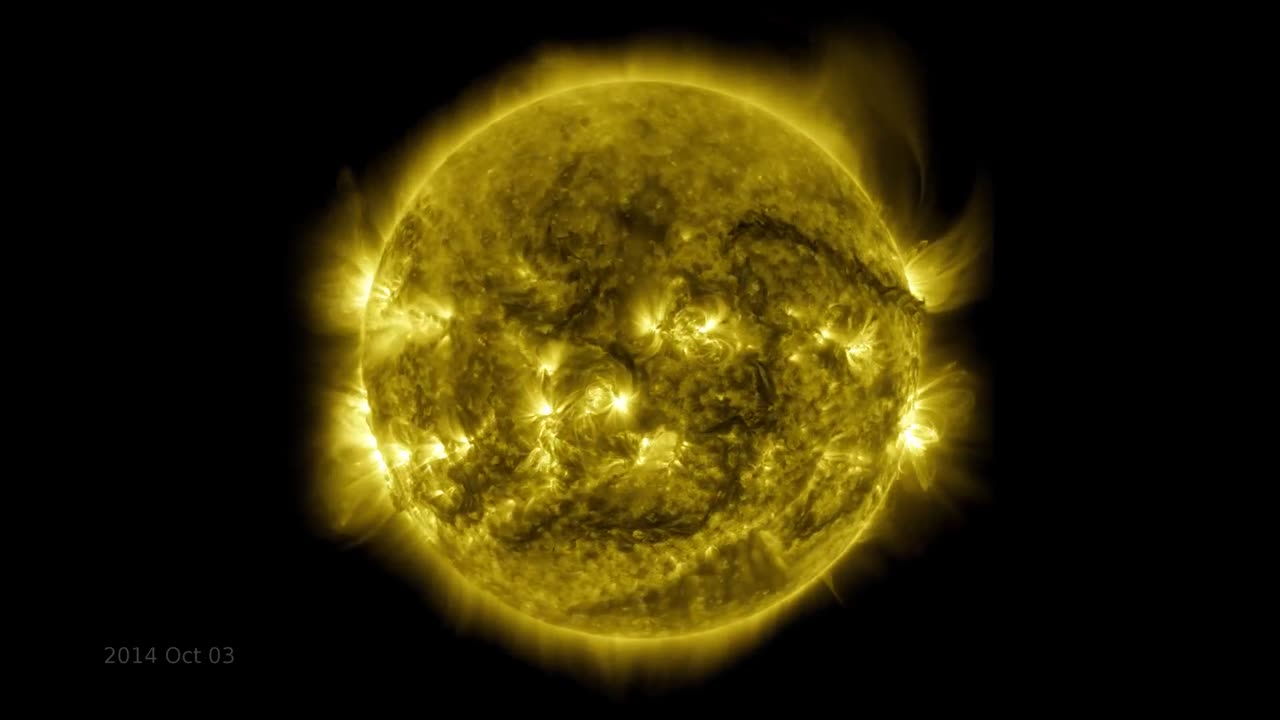Premium Only Content

A decade of the sun
NASA’s Solar Dynamics Observatory — SDO — has now been watching the Sun non-stop for over a full decade. From its orbit in space around the Earth, SDO has gathered 425 million high-resolution images of the Sun, amassing 20 million gigabytes of data over the past 10 years. This information has enabled countless new discoveries about the workings of our closest star and how it influences the solar system. With a triad of instruments, SDO captures an image of the Sun every 0.75 seconds. The Atmospheric Imaging Assembly (AIA) instrument alone captures images every 12 seconds at 10 different wavelengths of light. This 10-year time lapse showcases photos taken at a wavelength of 17.1 nanometers, which is an extreme ultraviolet wavelength that shows the Sun’s outermost atmospheric layer — the corona. Compiling one photo every hour, the movie condenses a decade of the Sun into 61 minutes. The video shows the rise and fall in activity that occurs as part of the Sun’s 11-year solar cycle and notable events, like transiting planets and eruptions. The custom music, titled “Solar Observer,” was composed by musician Lars Leonhard (https://www.lars-leonhard.de). While SDO has kept an unblinking eye pointed towards the Sun, there have been a few moments it missed. The dark frames in the video are caused by Earth or the Moon eclipsing SDO as they pass between the spacecraft and the Sun. A longer blackout in 2016 was caused by a temporary issue with the AIA instrument that was successfully resolved after a week. The images where the Sun is off-center were observed when SDO was calibrating its instruments. SDO and other NASA missions will continue to watch our Sun in the years to come, providing further insights about our place in space and information to keep our astronauts and assets safe. Some noteworthy events appear briefly in this time lapse. Use the time links below to jump to each event, or follow the links to more detailed views. 6:20 June 7, 2011-- A massive prominence eruption explodes from the lower right of the Sun. See the video: https://www.youtube.com/watch?v=HloC4xMg4Z4 https://svs.gsfc.nasa.gov/10801 12:24 June 5, 2012-- The transit of Venus across the face of the Sun. Won’t happen again until 2117. See the video: https://www.youtube.com/watch?v=4Z9rM8ChTjY https://svs.gsfc.nasa.gov/10996 13:06 July 19, 2012-- A complex loop of magnetic fields and plasma forms and lasts for hours. See the video: https://www.youtube.com/watch?v=HFT7ATLQQx8 https://svs.gsfc.nasa.gov/11168 13:50 Aug. 31, 2012-- The most iconic eruption of this solar cycle bursts from the lower left of the Sun. See the video: https://www.youtube.com/watch?v=GrnGi-q6iWc https://svs.gsfc.nasa.gov/11095 20:25 Sept. 29, 2013-- A prominence eruption forms a long 'canyon’ that is then covered with loops of plasma. See the video: https://www.youtube.com/watch?v=Qurh_BZ-O2E https://svs.gsfc.nasa.gov/11379 26:39 Oct. 8, 2014-- Active regions on the Sun resemble a jack o’ lantern just in time for Halloween. https://svs.gsfc.nasa.gov/11711 36:18 May 9, 2016-- Mercury transits across the face of the Sun. Smaller and more distant than Venus it is hard to spot. See the video: https://www.youtube.com/watch?v=PhO6Ufw9h_s https://svs.gsfc.nasa.gov/12235 43:20 July 5, 2017-- A large sunspot group spends two weeks crossing the face of the Sun.
#DecadeOfTheSun
#SolarExploration
#NASA
#SolarScience
#SpaceResearch
#SunProbe
#SolarObservations
#SpaceDiscoveries
#SunScience
#SpaceMissions
#SolarSystem
#SunExploration
#Astronomy
#SpaceTechnology
#SolarDynamicsObservatory
#SunData
#SpaceInnovation
#SpaceExploration
#SunResearch
#NASAmissions
-
 LIVE
LIVE
TheSaf3Hav3n
4 hours ago $3.04 earnedCALL OF DUTY: BLACK OPS 6 | A QUIET PLACE: THE ROAD AHEAD | #RumbleTakeOver
1,052 watching -
 LIVE
LIVE
TheNateVibez
3 hours agoOmni-🤖 - First Rumble Stream.🫡 - VETERAN
1,676 watching -
 2:59:26
2:59:26
Tundra Gaming Live
8 hours ago $1.92 earnedThe Worlds Okayest War Thunder Stream//FORMER F-16 MAINTAINER//77th FS//#rumblefam
13K -
 2:32:19
2:32:19
DemolitionDx
3 hours agoSunday night COD with friends.
45.2K1 -
 2:10:14
2:10:14
vivafrei
14 hours agoEp. 237: More Trump Cabinet Picks! MAHA or Slap in the Face? Canada on Fire! Go Woke Go Broke & MORE
185K228 -
 2:23:21
2:23:21
SOLTEKGG
4 hours ago $2.80 earned🟢 First Day on RUMBLE!
30.2K3 -
 LIVE
LIVE
Vigilant News Network
8 hours agoCOVID-Vaccinated Hit With Grave New Reality | Media Blackout
2,014 watching -
 1:26:31
1:26:31
Josh Pate's College Football Show
7 hours ago $2.20 earnedSEC Disaster Saturday | Major CFP Earthquake Coming | Officiating Is A Disaster | New Studio Debut
25.8K1 -
 1:43:05
1:43:05
Adam Does Movies
11 hours ago $3.93 earnedGladiator II Spoiler Conversation With Hack The Movies
27.4K1 -
 24:10
24:10
Bwian
11 hours agoI Don't Know What I'm Doing in Fortnite, But I Still Won...
18.9K1